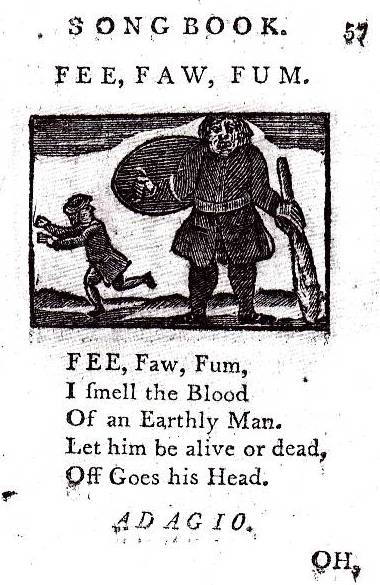|
This incomprehensible phrase is most famous for appearing in "Jack the Giant Killer." Most versions adhere to basically the same model:
Fee-fi-fo-fum I smell the blood of an Englishman. Be he alive or be he dead I'll grind his bones to make my bread. What does "fee-fi-fo-fum" actually mean? Nobody knows. Although there have been theories. (Does fie mean a cry of disapproval, as in "Fie! Fie!"? Or does it come from the Gaelic word for "tasty"? I'm leaning towards "neither, just a nonsense phrase.") When Thomas Nashe mentioned it in Have with you to Saffron-walden (1596), it was already an old saying of obscure origin. "O, tis a precious apothegmatical Pedant, who will find matter enough to dilate a whole day of the first invention of Fy, fa, fum, I smell the blood of an English-man". (I have to say, I love that paragraph.) It also appears in King Lear (1605): Child Roland to the dark tower came, His word was still, Fie, foh, and fum, I smell the blood of a British man. In 1814, Robert Jamieson's version of Childe Rowland in Illustrations of Northern Antiquities had the Elf-king proclaim, "With fi, fi, fo, and fum! I smell the blood of a Christian man! Be he dead, be he living, wi' my brand I'll clash his harns frae his harn-pan! " [I'll dash his brains from his brain-pan] And in Tom Thumb (1621) - on this blog you know it's always going to come back to Tom Thumb - the hero encounters a giant who says, Now fi, fee, fau, fan, I feele smell of a dangerous man, Be he alive, or be he dead, He grind his bones to make me bread. So, by 1621, the rhyme was already associated with giants, and the colorfully gruesome idea of bone-meal bread was in existence. (Tom Thumb, as well as being the first fairytale printed in English, has lots of common fairy tale tropes, such as the fairy godmother.) So the phrase fee-fi-fo-fum has been around a long time. It first appeared in print in combination with Jack the Giant Killer when that story was printed in 1711. Regarding Childe Rowland, Jamieson recalled hearing a version in his childhood from a tailor: "the tailor curled up his nose, and sniffed all about, to imitate the action which "fi, fi, fo, fum!" is intended to represent." So maybe "fee fi fo fum" is meant to be some kind of onomatopoeia for smelling? I don't know how that would work, but I do find the different variations interesting. It looks like it was once more common to have only three syllables instead of four. Although this phrase is English, there are parallels to monsters detecting people by the smell of their blood in other countries. In Perrault's Popular Tales, Andrew Lang connects this theme to the Furies in Aseschylus' Eumenides. Text copyright © Writing in Margins, All Rights Reserved
2 Comments
11/9/2020 02:05:01 pm
Hi, I just wondered what you thoughts are about the bone meal bread, the "nasty" miller who adulterates the flour with ossified bones. and the eucharist, bread as flesh. I am writing about folklore and bread. I would be very interested in your thoughts. thanks michael
Reply
Writing in Margins
11/11/2020 01:34:00 pm
I don’t think there’s much historical precedent for a correlation between those things, but that’s an interesting approach to take. There's a world of difference from the threat of grinding bones to make flour, to the concept of bread becoming Christ's flesh. You could make a case with the giant's threat sometimes being aimed at "a Christian man," although I’d also note that Christian here is interchangeable with "earthly man" or "Englishman." I’m afraid I don’t have much else to add, but thank you for the comment! Good luck with your writing.
Reply
Leave a Reply. |
About
Researching folktales and fairies, with a focus on common tale types. Archives
July 2024
Categories
All
|
Writing in Margins

 RSS Feed
RSS Feed
